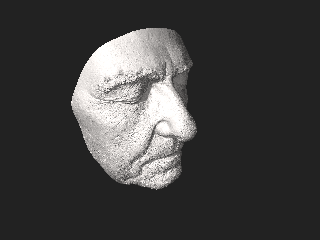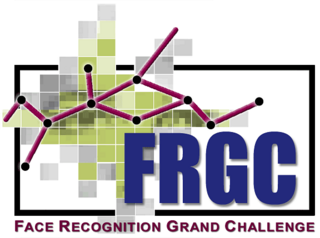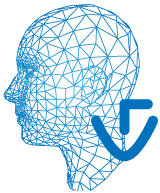Biometrics are body measurements and calculations related to human characteristics. Biometric authentication is used in computer science as a form of identification and access control. It is also used to identify individuals in groups that are under surveillance.

A facial recognition system is a technology potentially capable of matching a human face from a digital image or a video frame against a database of faces. Such a system is typically employed to authenticate users through ID verification services, and works by pinpointing and measuring facial features from a given image.

Three-dimensional face recognition is a modality of facial recognition methods in which the three-dimensional geometry of the human face is used. It has been shown that 3D face recognition methods can achieve significantly higher accuracy than their 2D counterparts, rivaling fingerprint recognition.
Private biometrics is a form of encrypted biometrics, also called privacy-preserving biometric authentication methods, in which the biometric payload is a one-way, homomorphically encrypted feature vector that is 0.05% the size of the original biometric template and can be searched with full accuracy, speed and privacy. The feature vector's homomorphic encryption allows search and match to be conducted in polynomial time on an encrypted dataset and the search result is returned as an encrypted match. One or more computing devices may use an encrypted feature vector to verify an individual person or identify an individual in a datastore without storing, sending or receiving plaintext biometric data within or between computing devices or any other entity. The purpose of private biometrics is to allow a person to be identified or authenticated while guaranteeing individual privacy and fundamental human rights by only operating on biometric data in the encrypted space. Some private biometrics including fingerprint authentication methods, face authentication methods, and identity-matching algorithms according to bodily features. Private biometrics are constantly evolving based on the changing nature of privacy needs, identity theft, and biotechnology.
Next Generation Identification (NGI) is a project of the Federal Bureau of Investigation (FBI). The project's goal is to expand the capabilities of the Integrated Automated Fingerprint Identification System (IAFIS), which is currently used by law enforcement to identify subjects by their fingerprints and to look up their criminal history. The NGI system will be a more modular system. It will also have more advanced lookup capabilities, incorporating palm print, iris, and facial identification. The FBI first used this system in February 2011.

The Face Recognition Grand Challenge (FRGC) was conducted from May 2004 until March 2006 to promote and advance face recognition technology. It succeeded the Face Recognition Vendor Test.
Facial Profiler was a free Facebook app created to promote Coca-Cola Zero by the advertising agency Crispin Porter + Bogusky. The app used face recognition technology to search a database of voluntarily participating Facebook users to match people based on appearance. The software's algorithm analyzed face attributes like skin color, face structure and angles of the face. Once matched, users could contact their look-alike via their Facebook profile.
Identity-based security is a type of security that focuses on access to digital information or services based on the authenticated identity of an entity. It ensures that the users and services of these digital resources are entitled to what they receive. The most common form of identity-based security involves the login of an account with a username and password. However, recent technology has evolved into fingerprinting or facial recognition.

A biometric device is a security identification and authentication device. Such devices use automated methods of verifying or recognising the identity of a living person based on a physiological or behavioral characteristic. These characteristics include fingerprints, facial images, iris and voice recognition.

Visage SDK is a multi-platform software development kit (SDK) created by Visage Technologies AB. Visage SDK allows software programmers to build facial motion capture and eye tracking applications.
FindFace is a face recognition technology developed by the Russian company NtechLab that specializes in neural network tools. The company provides a line of services for the state and various business sectors based on FindFace algorithm. Previously, the technology was used as a web service that helped to find people on the VK social network using their photos.
The Biometric Information Privacy Act is a law set forth on October 3, 2008 in the U.S. state of Illinois, in an effort to regulate the collection, use, and handling of biometric identifiers and information by private entities. Notably, the Act does not apply to government entities. While Texas and Washington are the only other states that implemented similar biometric protections, BIPA is the most stringent. The Act prescribes $1,000 per violation, and $5,000 per violation if the violation is intentional or reckless. Because of this damages provision, the BIPA has spawned several class action lawsuits.
Local differential privacy (LDP) is a model of differential privacy with the added requirement that if an adversary has access to the personal responses of an individual in the database, that adversary will still be unable to learn much of the user's personal data. This is contrasted with global differential privacy, a model of differential privacy that incorporates a central aggregator with access to the raw data.
Amazon Rekognition is a cloud-based software as a service (SaaS) computer vision platform that was launched in 2016. It has been sold to, and used by, a number of United States government agencies, including U.S. Immigration and Customs Enforcement (ICE) and Orlando, Florida police, as well as private entities.
Clearview AI is an American facial recognition company, providing software to law enforcement and government agencies and other organizations. The company's algorithm matches faces to a database of more than 20 billion images collected from the Internet, including social media applications. Founded by Hoan Ton-That and Richard Schwartz, the company maintained a low profile until late 2019, when its usage by law enforcement was reported. U.S. police have used the software to apprehend suspected criminals. Clearview's practices have lead to fines by EU nations for violating privacy laws and investigations in the U.S. and other countries as well.

Adam Harvey is an American artist and researcher based in Berlin whose work focuses on computer vision, digital imaging technologies, and counter surveillance. His work includes projects combining art and technology as well as speaking and hosting talks on topics relating to data and computer vision.
DataWorks Plus LLC is a privately held biometrics systems integrator based in Greenville, South Carolina. The company started in 2000 and originally focused on mugshot management, adding facial recognition beginning in 2005. Brad Bylenga is the CEO, and Todd Pastorini is the EVP and GM. Usage of the technology by police departments has resulted in wrongful arrests.
Identity replacement technology is any technology that is used to cover up all or parts of a person's identity, either in real life or virtually. This can include face masks, face authentication technology, and deepfakes on the Internet that spread fake editing of videos and images. Face replacement and identity masking are used by either criminals or law-abiding citizens. Identity replacement tech, when operated on by criminals, leads to heists or robbery activities. Law-abiding citizens utilize identity replacement technology to prevent government or various entities from tracking private information such as locations, social connections, and daily behaviors.

Fawkes is a facial image cloaking software created by the SAND Laboratory of the University of Chicago. It is a free tool that is available as a standalone executable. The software creates small alterations in images using artificial intelligence to protect the images from being recognized and matched by facial recognition software. The goal of the Fawkes program is to enable individuals to protect their own privacy from large data collection. As of May 2022, Fawkes v1.0 has surpassed 840,000 downloads. Eventually, the SAND Laboratory hopes to implement the software on a larger scale to combat unwarranted facial recognition software.
PimEyes is a facial recognition search website that allows users to identify all images on the internet of a person given a sample image. The website is owned by EMEARobotics, a corporation based in Dubai. The owner and CEO of EMEARobotics and PimEye is Giorgi Gobronidze who is based in Tbilisi, Georgia.







